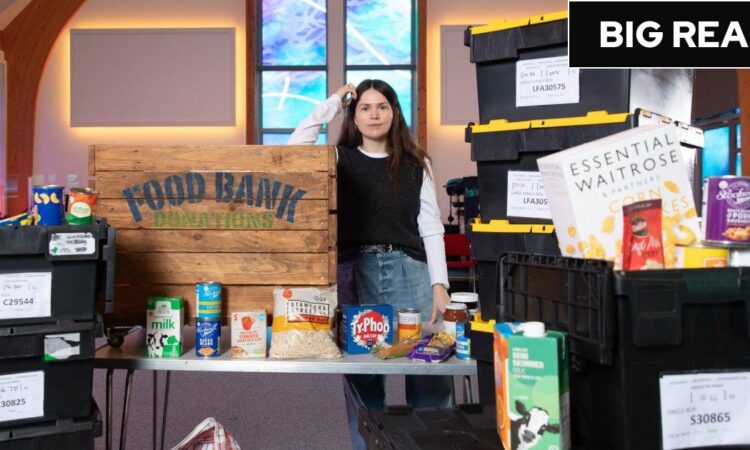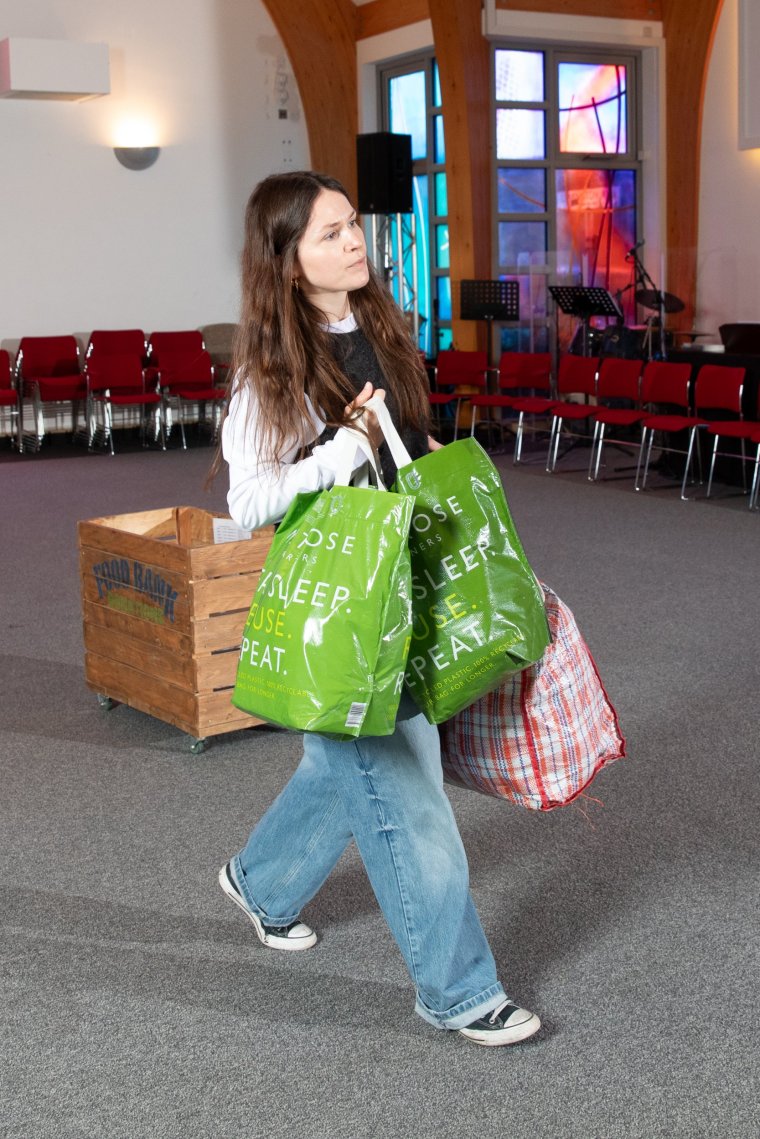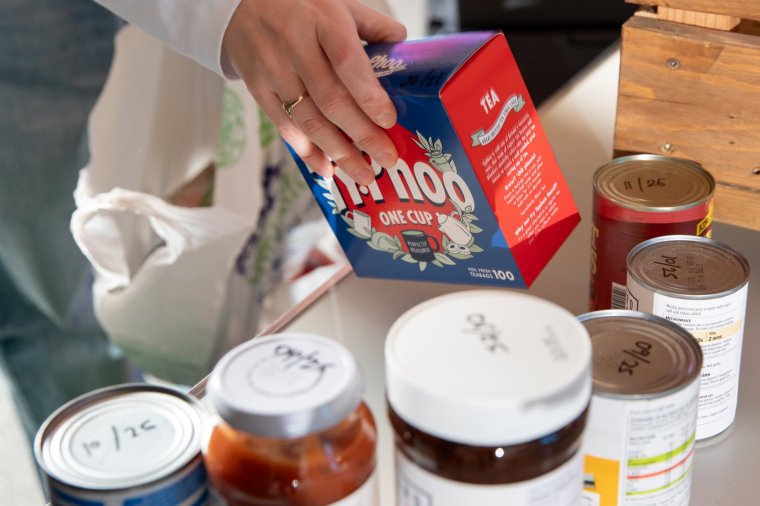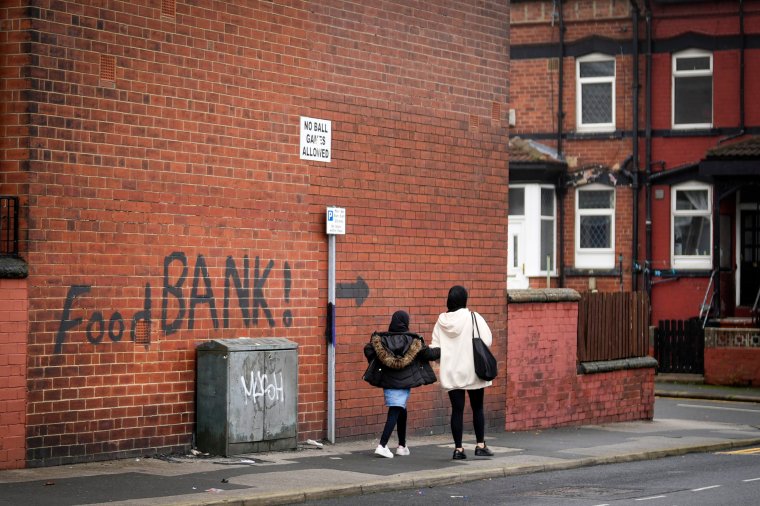
The man walked in and silently sat down, a large rucksack on his back, wearing a winter hat but no coat. I offered him a drink. Tea? Coffee? Bourbon biscuit? A glass of water? He politely declined and didn’t seem in the mood for a chat. This isn’t unusual. Often the first time that many people find themselves at a food bank they are full of heightened emotions. Sometimes embarrassment, shame, fear, overwhelm. The lingering question: how did I end up here?
I gathered his details and packed the reusable bags full of food (some baked beans, Fray Bentos pies, long-life milk, a box of cereal) – items are not given out in boxes to make it look as much like a supermarket shop as possible – while the man, in his late 50s, surveyed the church hall around us. The vaulted ceilings, the altar, the huge stained-glass windows. As I carried the bags over, he turned to me: “I was one of the builders on this church, I never got a chance to see it finished, and well… I didn’t think I’d be coming back under these circumstances,” his voice broke.
For 11 months, from 9.30 to 11am on a Saturday morning, I’ve been one of the 28,000 volunteers working for the Trussell Trust food bank network across the UK, running 1,300 food banks and donation centres. Trussell is not the only provider of food banks, there are also hundreds in the Independent Food Aid Network (Ifan) and places such as the Salvation Army – in fact, it is reported that there are now more food banks than McDonald’s in this country. I started working here when I moved out of London. I’ve always volunteered in some capacity or another and wanted to meet new people in my community so it made sense.
Today food banks face a two-pronged challenge – the numbers in need are rising to historic levels (on 21 March it was reported that the UK had seen the biggest rise in absolute poverty for 30 years) but donations are dropping off a cliff. Last winter, 225,000 people used a food bank for the first time, according to the Trussell Trust. Between April and September 2023 the network distributed 1.5 million parcels, an increase of 16 per cent on 2022. Six years ago, in 2018, that number was less than half (690,000).
In the past this demand was largely met by the community gifting food, but as the cost of living crisis continues to bite people are able to give less from their own pocket, while the number requiring help keeps growing.

The redbrick Baptist church is situated on a busy arterial road, opposite a Waitrose. It is an area of mixed wealth: at the weekend it plays host to a children’s ballet class, a bible studies group, and the food bank. The number of people coming through the door for food varies: sometimes just a couple and on other days – especially towards the end of the month, before payday – a constant stream. After the 90-minute session you can’t help but have it stick with you; people’s stories, their situations, their struggles.
Before I joined I imagined what it might be like: shelves of food lined up to be picked out for anyone who visited and was in need. Not quite. While the system might be kept running by an army of volunteers, it is a slick business-like operation with rules. The food – all non-perishable items, mostly tinned – comes prepackaged from a warehouse, divided up into plastic boxes big enough to give to a single-person household, a couple, a family, or a large family (more than two children). Everything is meticulously recorded and accounted for.
Food parcels are designed to last at least three days and to be nutritionally valuable without requiring huge amounts of gas or electricity to prepare. There are also supplementary items on offer: bus passes, toilet rolls, SIM cards, and ad hoc provisions of sanitary items when we can get them (pet food was in stock until an unfortunate incident with some cat food left in the sunshine). At Christmas there were chocolate selection boxes and fresh bags of Brussels sprouts.
When people come to the food bank they have to bring a voucher that acts as a referral of need from another service. There are 150 of these so-called referees, including Citizen’s Advice, social workers, doctors, teachers, the police, and – until recently – the job centre. The Department for Work and Pensions reportedly instructed job centres to no longer issue the slips because they are “inappropriate use of claimant data”. It is only with that voucher that food can be allocated. Without it, technically, the food is not supposed to be given out.

Why? The service is meant to be an emergency aid, and in theory acts as a way to signpost people on to places that can give proper help to address the issues that have brought that person there. But, for many, trapped in spirals of poverty or sickness, difficult relationships or ongoing mental health challenges, there is no simple solution.
There are always the regular faces – the pensioner who has had a nagging cough for months, and really seems to want company and a chat as much as he wants the food (he gives back certain bits from his bag insisting that he doesn’t need it all and someone else should have it). The Ukranian woman who fled home with her young son to take refuge in this corner of England. She doesn’t know where her husband is and struggles with the hour-long bus journey her child has to take twice a day from the accommodation they’ve been put in, to the school he was placed in on the other side of this foreign city. He loves the chocolates we pop into his bag.
There’s the woman with three young children whose husband – the breadwinner – recently left them. She’s wondering how she is going to make ends meet. She can’t work because of the children (to apply for universal credit takes at least five weeks for the first payment). Or another mum separated from her husband, but still sharing the same home. He has stopped paying the bills and is refusing to communicate – she has become so depressed that sometimes she can’t get out of bed.
Then there is the lorry driver in his early 50s, who worked his whole life but was recently made redundant and is struggling to find work. Or the painter-decorator who has injured his knee and hip and so can’t go out to earn. These people come here when they don’t know what else to do.

Modern poverty is often misunderstood – there’s a prevailing idea that you can’t possibly need help if you’re wearing trainers, drive a car or have a phone. I’ve had more than one person ask me: “Aren’t there just people looking for a free handout?”, echoing our political class, who say things like British workers just need “more graft” and “too many people in Britain prefer a lie-in to hard work”. But this is a complete misrepresentation of the reality so many people are facing.
Natasha, project manager for the food bank where I volunteer, agrees the biggest misconception she comes across is that “[these people] are homeless, that everyone who comes to us is on benefits. A lot of people think that people are taking advantage of ‘free food’.” People who come to the food bank frequently have jobs; one in five are in working households. They are teaching assistants, care workers, nurses, delivery drivers – or those who have recently stopped work after long careers paying into the system.
Food insecurity touches many more people than some would like to imagine: in 2023 a report by the Trussell Trust found 14 per cent of all adults (11.3m people) had experienced this in the 12 months to mid-2022, meaning they’d run out of food, been unable to afford to replenish the cupboards, reduced how much they were eating, or gone without, due to lack of money. These are the people in your community, those you walk past in the street, or see at the school gate.
The three main factors that lead people to food banks are, according to the same report, the way the social security system is set up and how that money is delivered; that going to work does not provide sufficient protection from financial hardship; and the difficulty of accessing jobs for people who are disabled, have caring responsibilities or are parents.
“Paid work is also not providing the reliable route out of hardship which we might expect,” it says. “[And] while insecure finances are the primary cause of food bank use, wider factors such as adverse life events and social isolation exacerbate [this]”.
“People [no longer] have the income to cover the essentials,” Natasha explains. “The rising cost of essentials is the main reason that people come to us now… I started working [here] in 2017. Our year-end number then was 4,776. The number of parcels last year was over 20,000. I can remember the record of seeing 35 vouchers fulfilled in one session was at Christmas a few years ago. That is now a quiet week at the same distribution centre.”
For those without a voucher, I have yet to see anyone turned away. The food bank instead dips into the separate supply of items left in the church donation box – the food banks in the Trussell network are independent charities so have this sort of discretionary power – but even that box is getting emptier as belts are tightened.
This hardening of times is having the dual effect of pushing more people into needing the food bank, and restricting the volume of donations. “A few years ago we were wondering how to deal with our excess baked beans and pasta,” says Natasha. But that is no longer the case. “Our donations have dropped so much that we had to put baked beans on our list of most needed items. We now buy around 50 per cent of the food that we give out.” Previously 90 per cent of food given out was sourced from donations.
In 2024, this is the new challenge food banks are facing. How do you deal with a population that is financially crippled and in need of help, when everyone else feels less able to help? (An additional problem is likely to come when the government ends the so-called Household Support Fund – a pot of grant money the Trussell Trust and other charities have been relying on- it is due to end in September).
The survival of food banks isn’t just a matter of giving people their next meal, but ensuring someone is on the frontlines for a variety of social ills. The man who comes through the door to get a bag of food, but also needs advice for where to go with a rotting tooth because he can’t get to the dentist. Or the woman sent by the police after a domestic abuse incident, who can’t bear the idea of beginning a new life and having nothing in the cupboard to eat. Giving these people help means wrestling with a kaleidoscope of overlapping issues.
In the 12 months I’ve been at the food bank I’ve seen this conundrum up close. Although it should go without saying that it is hugely rewarding (I’m not religious, it is just nice to feel you can help others in a small way) it also forces you to confront the difficult reality that so many across Britain face today: that being in work doesn’t necessarily keep enough food on the table and that the safety nets we hope are in place to catch us if we fall, might turn out to be less robust than we would wish.
Many of us naively tell ourselves it could never be us or the people we know. But we’re wrong. The transition between keeping afloat and drowning can happen much quicker than you might think.






